Chapter 5
Using Siri for E-Mail, Texting, and Phone Calls
In This Chapter
![]() Sending an e-mail using your voice — even to multiple people at once
Sending an e-mail using your voice — even to multiple people at once
![]() Using the CC and BCC fields
Using the CC and BCC fields
![]() Having Siri find e-mails in your inbox
Having Siri find e-mails in your inbox
![]() Replying and forwarding e-mail messages
Replying and forwarding e-mail messages
![]() Composing text messages through Siri
Composing text messages through Siri
![]() Having Siri read your text messages to you
Having Siri read your text messages to you
![]() Using your voice to make phone calls and initiate FaceTime calls
Using your voice to make phone calls and initiate FaceTime calls
In this chapter — and it’s one of the longer ones — you get to see how you can use Siri as your personal communication tool.
Specifically, your voice-activated personal assistant on iPhone, iPad, or iPod touch can be very handy for composing and accessing e-mails, composing and reading iMessages and text messages (SMS), and for iPhone users, placing a phone call to a particular number or someone in your Contacts (address book).
There’s quite a lot to cover, so I want to jump right in and begin.
“Siri, Take a Letter”
One of the most impressive — and convenient — things Siri can do is send your e-mails for you.
Siri can transcribe your words into text so that you only need to talk into your iPhone, iPad, or iPod touch. Siri will then type out the words you say, including the name of the person or group you’re sending it to, the subject line, and the body of the message.
You’ll find this can really speed up your “written” communication on your favorite iDevice. In fact, experts say talking is three to four times faster than typing. Plus, not everyone is as fast or accurate on an all-touch smartphone as they are on those button-based ones out there. (Think BlackBerry smartphones.)
In other words, using Siri for sending e-mails not only catches up to other phones, but blows past it.
In this chapter, I show you how to use Siri to send e-mails to family, friends, and colleagues — whether they’re in your Contacts or not.
Composing, Sending, and Accessing E-Mails
You have two ways to start composing an e-mail using Siri. You can start right from your home screen — as if you just turned on your smartphone, tablet, or media player — by pressing and holding the Home button (or if it’s set up to do so, by holding your iPhone up to your ear). The other way to have Siri transcribe your words into text is to start a message to someone the old-fashioned way (typing), and then tap the microphone icon to start talking. Figure 5-1 shows you what you might see if you were to talk into your iOS device.
Here’s a closer look at both options.

Figure 5-1: Siri types your spoken e-mails for you.
Starting and sending an e-mail from scratch
Okay, so you realize you need to send an e-mail to someone while you’re walking down the street and you don’t want to stop to type the message. There is a better way. Pull out your smartphone, press the Home button, and then start talking.
In this section, I explain the simplest way to send an e-mail. I cover the fastest way to send an e-mail later in the chapter.
Here’s the blow-by-blow account for starting an e-mail using Siri:
1. Press and hold the Home button.
The little chime you hear means Siri is listening for your instructions.
2. Say the word “E-mail” and then the name of the person you want to e-mail.
Siri opens your mail program and puts the name of the person you’re e-mailing in the To field — if they’re in your address book. (See the “E-mailing someone who isn’t in your Contacts” section, later in this chapter, to find out how to e-mail someone who isn’t in your Contacts.)
3. Dictate your e-mail.
When you’re done, Siri shows you the contents of your message on the screen, as shown in Figure 5-2. For example, you can say “E-mail Mary Smith [short pause]. Hi Mary, hope you’re having a good day. This is just a reminder about our meeting at 3 p.m. See you then.”
 Take advantage of the fact that Siri previews your e-mail by showing you the contents of your message on the screen by taking the time to review your e-mail, just in case you need to tweak it, add more recipients, and so on, before sending it.
Take advantage of the fact that Siri previews your e-mail by showing you the contents of your message on the screen by taking the time to review your e-mail, just in case you need to tweak it, add more recipients, and so on, before sending it.
Siri next asks you, “What’s the subject of your e-mail?”
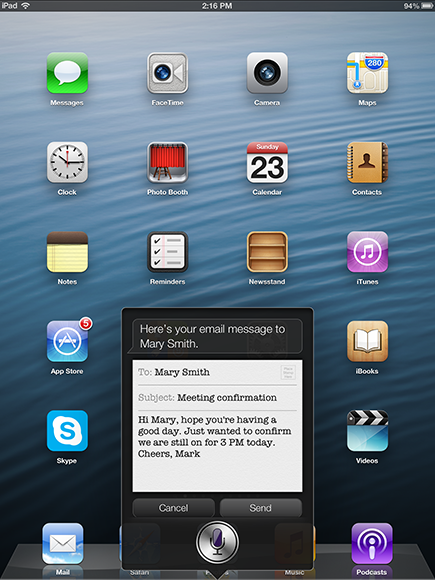
Figure 5-2: Siri lets you review your e-mail before sending it.
4. Say what you’d like the subject line to say, such as, “Meeting confirmation.”
Siri again shows you what your e-mail currently looks like — now you should be able to see the person you’re sending it to, what the subject is, and the body of the e-mail. Siri says, “Here’s what your e-mail looks like. Ready to send it?” If you’re in fact ready to send it, you can let ’er fly.
5. Review all fields, and then say, “Okay,” “Yes,” “No,” or “Cancel.”
Alternatively, you can tap the appropriate response — Cancel or Send— if you prefer.
If you say “Yes” or tap Send, then it’s bye-bye e-mail. Your e-mail message is sent, and you’ll hear that “whoosh” sound as a confirmation.
If you say “No” or tap Cancel, the message is canceled, and you’ll see a large red CANCELED stamp across the message. It won’t be saved as a draft.
![]() Teach Siri who your contacts are. When you’re starting an e-mail and say, “E-mail Dad,” for the first time, Siri asks who your dad is. You’re prompted to tap the contact name in your Contacts listing for your dad.
Teach Siri who your contacts are. When you’re starting an e-mail and say, “E-mail Dad,” for the first time, Siri asks who your dad is. You’re prompted to tap the contact name in your Contacts listing for your dad.
You can edit your own Contacts entry (your name) and scroll down to see where you can add relationships, such as spouse, parents, and so forth.
Going forward, you can simply say, “E-mail Dad,” and Siri knows whose address to retrieve; you won’t have to tap the name again.
![]() Correct mistakes and make other changes. If you make a mistake and need to change your e-mail, say, “Change subject,” or “Change e-mail,” and then give Siri a revised message for the recipient. In Figure 5-3, for example, Siri misspelled my name (Mark instead of Marc, believe it or not), but it allowed me to correct the mistake by repeating the request a few times and Siri, the third time, finally showed me “Marc” instead of “Mark,” and so I accepted. This usually works.
Correct mistakes and make other changes. If you make a mistake and need to change your e-mail, say, “Change subject,” or “Change e-mail,” and then give Siri a revised message for the recipient. In Figure 5-3, for example, Siri misspelled my name (Mark instead of Marc, believe it or not), but it allowed me to correct the mistake by repeating the request a few times and Siri, the third time, finally showed me “Marc” instead of “Mark,” and so I accepted. This usually works.
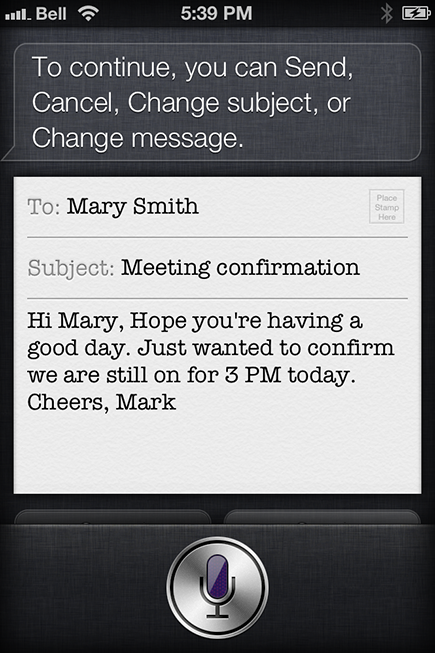
Figure 5-3: Siri allows you to edit messages.
![]() Tell Siri which e-mail address to send a message to. If you have multiple e-mail addresses for someone in your Contacts, you can instruct Siri to e-mail a specific address. For example, you might have a friend with a work and home e-mail address, and don’t want to send a private message about an upcoming party to your best friend’s work address. Simply tell Siri “E-mail [friend’s name],” followed by “[work or home],” followed by “[message].” Also, if you have more than one, say, Mary Smith in your Contacts, it might ask you to select one over another.
Tell Siri which e-mail address to send a message to. If you have multiple e-mail addresses for someone in your Contacts, you can instruct Siri to e-mail a specific address. For example, you might have a friend with a work and home e-mail address, and don’t want to send a private message about an upcoming party to your best friend’s work address. Simply tell Siri “E-mail [friend’s name],” followed by “[work or home],” followed by “[message].” Also, if you have more than one, say, Mary Smith in your Contacts, it might ask you to select one over another.
![]() Cancel messages. To cancel the message altogether, say “No” or “Cancel” when Siri asks you if it’s OK to send the message.
Cancel messages. To cancel the message altogether, say “No” or “Cancel” when Siri asks you if it’s OK to send the message.
 You can always tap the microphone button to cancel your last request.
You can always tap the microphone button to cancel your last request.
If you want to make sure that Siri understood you, check to see if a large red CANCELED stamp appears across your e-mail message, as shown in Figure 5-4.
![]() Have Siri type the subject line first. To do so, say “subject” right after you say the receiver’s name, and Siri regards the next few words out of your mouth as the subject line, as shown in Figure 5-5. Only after she enters the subject does she prompt you to dictate the body of the e-mail.
Have Siri type the subject line first. To do so, say “subject” right after you say the receiver’s name, and Siri regards the next few words out of your mouth as the subject line, as shown in Figure 5-5. Only after she enters the subject does she prompt you to dictate the body of the e-mail.
For example, say “E-Mail Mary Smith [slight pause], work, subject [slight pause], meeting confirmation.” Now, press the Home button or wait a second, and Siri will ask you, “Okay, what would you like the e-mail to say?” Now you can dictate the body of the e-mail and have Siri send it for you, hands-free.
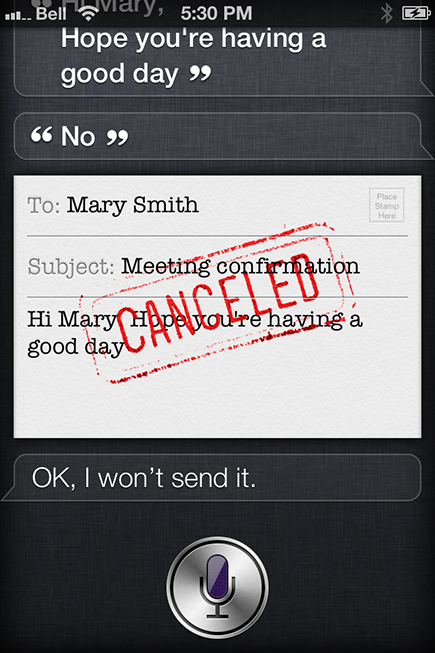
Figure 5-4: A large CANCELED stamp appears across any message you choose not to send.

Figure 5-5: Say the e-mail subject line first and then dictate the body.
Having Siri finish an e-mail you started to type
The second way you can send an e-mail using your voice is to start an e-mail the regular way — by tapping the E-mail icon and then tapping to select to whom you’re sending the message. The screen shown in Figure 5-6 appears. Notice the microphone icon at the bottom of the screen, to the left of the spacebar. Simply tap that icon and begin dictating into the iPhone, iPad, or iPod touch; you’ll see your words appear on the white canvas, as if you were typing them yourself. Before you send it, however, quickly scan for errors.
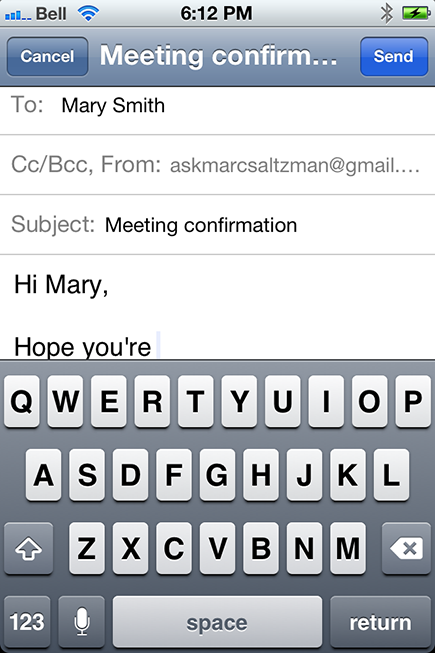
Figure 5-6: Tap the microphone icon to dictate your e-mail inside the message.

Figure 5-7: Siri lets you say all three parts to the e-mail, all in one shot.
Sending e-mail to groups
You can have Siri send an e-mail to a number of people at once — and you won’t believe how easy it is. Just follow these steps:
1. Say everyone’s name you want to e-mail the message to.
For instance, say, “Send an e-mail to Dad and my wife and Mary Smith and Mike Jones.”
 You must say “and” in between each of the recipients’ names. If Siri is unsure about someone (such as having three contacts with the name Kellie or Kelly), Siri will ask you to confirm which one you want to send the correspondence to.
You must say “and” in between each of the recipients’ names. If Siri is unsure about someone (such as having three contacts with the name Kellie or Kelly), Siri will ask you to confirm which one you want to send the correspondence to.
Siri asks, “What would you like to say to these four people?” and you’ll see them all in the To field, as shown in Figure 5-8.
2. Answer Siri by dictating your group message.
Siri asks if you’re ready to send it.
3. Say “Yes” to send the message.
You’ll hear the familiar confirmation sound, confirming that the message was sent.
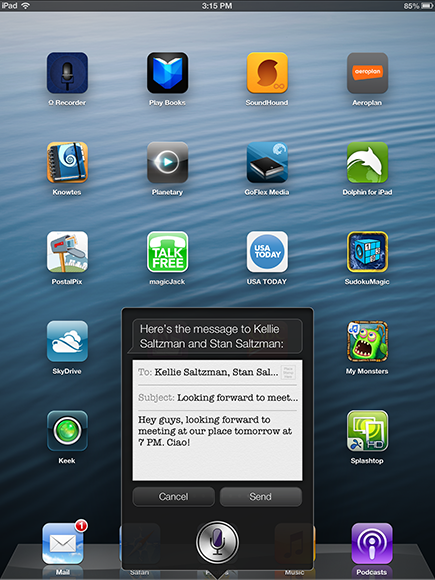
Figure 5-8: A message to a group looks like a message to a single recipient.
4. (Optional) If you need to tweak a couple of things, tap anywhere on the screen and make your changes before sending.
If you decide to manually tweak your message, the e-mail now looks like one you may have typed from the get-go. (See Figure 5-9.)
Siri e-mail grab bag
Siri is multitalented, so you might have trouble keeping up with all she can do. The following list gives you an idea of the range of things Siri can do:
![]() Send an e-mail while wearing a headset, microphone, or Bluetooth headset. If you’re using headphones with a remote and microphone on the cord, simply press and hold the center button to talk to Siri. If you’re wearing a Bluetooth headset, on the other hand, press and hold the call button to bring up Siri’s tone, which means you can begin asking a question or giving a command. Keep in mind, however, that speakerphones in your vehicle might not work as well with Siri, because your mouth is farther away from the microphone, which can pick up more background noise.
Send an e-mail while wearing a headset, microphone, or Bluetooth headset. If you’re using headphones with a remote and microphone on the cord, simply press and hold the center button to talk to Siri. If you’re wearing a Bluetooth headset, on the other hand, press and hold the call button to bring up Siri’s tone, which means you can begin asking a question or giving a command. Keep in mind, however, that speakerphones in your vehicle might not work as well with Siri, because your mouth is farther away from the microphone, which can pick up more background noise.

![]() If you’re unsure what Siri can do, just ask! You can literally ask your personal assistant what she (a female voice in North America) is capable of, and you’ll see a laundry list of things she can perform for you. If you want specific examples, tap one of Siri’s initial suggestions. For instance, if you want to know how to use Siri for sending e-mails, tap the line that says “E-mail Lisa about the trip,” and this will open up a dozen more examples of ways to use Siri for e-mail.
If you’re unsure what Siri can do, just ask! You can literally ask your personal assistant what she (a female voice in North America) is capable of, and you’ll see a laundry list of things she can perform for you. If you want specific examples, tap one of Siri’s initial suggestions. For instance, if you want to know how to use Siri for sending e-mails, tap the line that says “E-mail Lisa about the trip,” and this will open up a dozen more examples of ways to use Siri for e-mail.
![]() Include punctuation in an e-mail message. To do so, just say it out loud. For example, to finish a sentence you can say, “period.” Asking a question? Be sure to say, “question mark,” at the end of the sentence. You can also say, “exclamation mark,” “comma,” “semicolon,” “quote” (or “quotation mark”), and so on.
Include punctuation in an e-mail message. To do so, just say it out loud. For example, to finish a sentence you can say, “period.” Asking a question? Be sure to say, “question mark,” at the end of the sentence. You can also say, “exclamation mark,” “comma,” “semicolon,” “quote” (or “quotation mark”), and so on.

Figure 5-9: Tap anywhere on the screen to make changes.
You can even say, “smiley face,” and you’ll see the emoticon (sideways smiley face) on the screen! See Figure 5-10 for an example of Siri’s work — with 100 percent accuracy, no less. Also try saying “frowny face” (when you’re not happy) or “winky face” (sly, flirty).
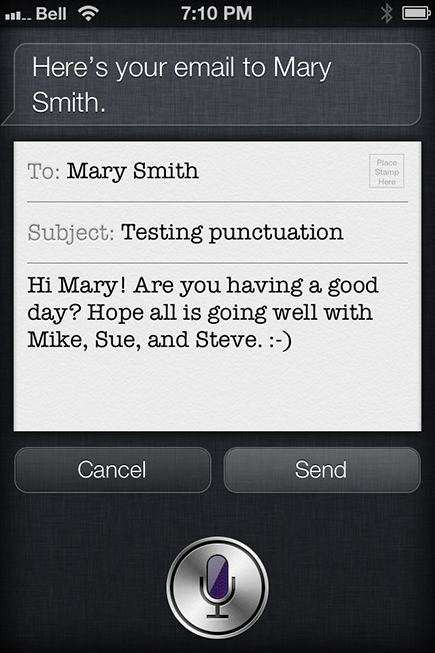
Figure 5-10: Testing the punctuation options, including “exclamation mark” and “smiley face.”
Table 5-1, 5-2, and 5-3 list many formatting, punctuation, financial, and mathematical commands to create the perfect e-mail using Siri on your iPhone, iPad, or new iPod touch. Most of these commands will work in a text message or the Notes app, too. On the left is what you should say to perform the design action on the right.
Table 5-1 Formatting Commands
|
When You Say This |
Siri Does This |
|
“new line” |
Moves down to the next line (as though you’ve pressed Return or Enter on a computer keyboard) |
|
“new paragraph” |
Starts a new paragraph |
|
“caps on” |
Capitalizes all following words |
|
“caps off” |
Turns off capitalization |
Table 5-2 Punctuation Commands
|
When You Say This |
Siri Adds This |
|
“period” or “dot” |
. |
|
“ellipsis” or “dot dot dot” |
... |
|
“dash” or “hyphen” |
– |
|
“em dash” |
— (double-length dash) |
|
“comma” |
, |
|
“underscore” |
_ |
|
“forward slash” |
/ |
|
“back slash” |
|
|
“vertical bar” |
| |
|
“quote” or “quotation mark” |
“ (until you say “quote” or “quotation mark” again) |
|
“exclamation point” |
! |
|
“question mark” |
? |
|
“ampersand” |
& |
|
“asterisk” |
* |
|
“at sign” |
@ |
|
“copyright sign” |
© |
|
“registered sign” |
® |
|
“degree sign” |
° |
|
“caret” |
^ |
|
“open parenthesis” or “close parenthesis” |
( or ) |
|
“open bracket” or “close bracket” |
[ or ] |
|
“open brace” or “close brace” |
{ or } |
Table 5-3 Math and Finance Commands
|
When You Say This |
Siri Adds This |
|
“plus sign” |
+ |
|
“minus sign” |
- |
|
“equals sign” |
= |
|
“percent sign” |
% |
|
“dollar sign” |
$ |
|
“cent sign” |
¢ |
|
“pound sterling” sign |
£ |
|
“pound sign” |
# |
|
“euro sign” |
€ |
|
“yen sign” |
¥ |
|
“degree sign” |
° |
|
“caret” |
^ |
|
“greater than sign” |
> |
|
“less than sign” |
< |
CCing and BCCing contacts in an e-mail
Just like in a regular e-mail, you can send an e-mail to one person and carbon copy, or CC, another person, so they also receive the same e-mail as the main recipient.
As you’d expect with Siri, all you need to do is send an e-mail to someone (in my example from Figure 5-11, that person is Mary Smith) and then take a short pause, say “CC,” then mention someone else from your Contacts (in this case, Mike Jones). Then you can say “subject” and tell Siri what you want your subject line to be.
Alternatively, you can say “carbon copy” instead of “CC.” Figure 5-12 shows this method works, too.
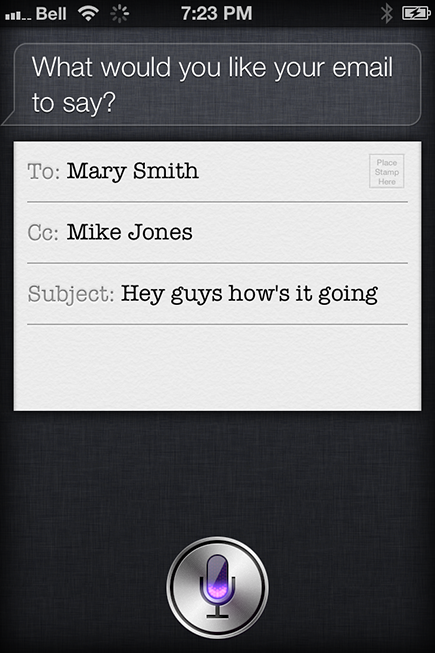
Figure 5-11: Saying “CC” keeps someone else in the loop.
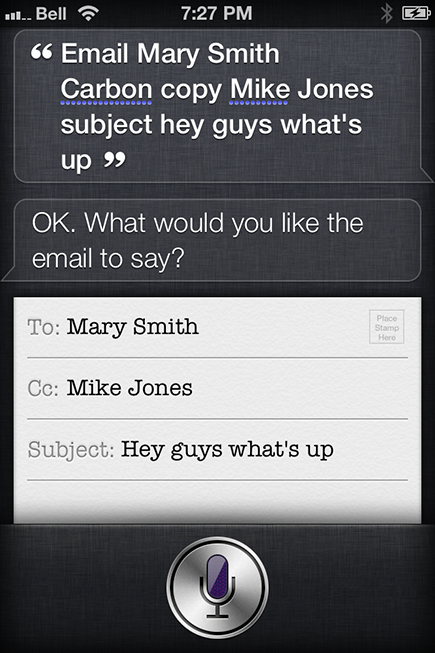
Figure 5-12: Saying “carbon copy” works too.
And of course, you can also “BCC” or blind carbon copy someone when sending an e-mail. For the uninitiated, specifying “BCC” means someone else is included on the e-mail — but the main recipient (and perhaps people you’ve also CC’d) won’t have a clue because they won’t see any mention of the other person’s name or e-mail address.
Of course, you can CC one person (or many people) and BCC someone else (or a whole bunch of somebody else’s) within the same e-mail.
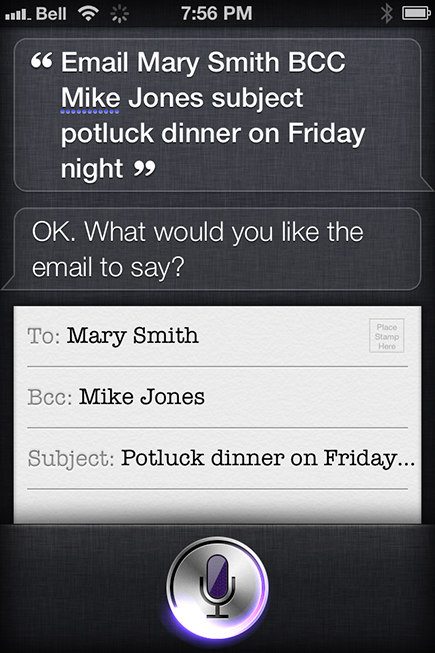
Figure 5-13: Add e-mail recipients to the blind carbon copy field of the message by simply saying “BCC.”
More E-Mail Tasks Siri Can Do for You
As late-night infomercial guru Ron Popeil says, “But wait; there’s more!” Siri can also do these e-mail–related tasks for you.
E-mailing someone who isn’t in your Contacts
In earlier sections of this chapter, I discuss e-mailing people who are already in your Contacts. But what if you need to send an e-mail to someone who’s not listed there?
Using Siri to send an e-mail to a specific address — one you might not have in your Contacts or care to add — is as simple as speaking the address aloud.
Here’s how to do it:
1. Press and hold the Home button and tell Siri to send an e-mail to someone by saying their complete e-mail address.
For example, to send an e-mail to [email protected] (just making this one up), simply say, “E-mail Richard dot Anderson at bigtimeisp dot com.”
The e-mail address appears in the To field, as shown in Figure 5-14.
2. Add a subject and dictate your e-mail.
Siri transcribes your words, and then asks if you’re ready to send the e-mail.
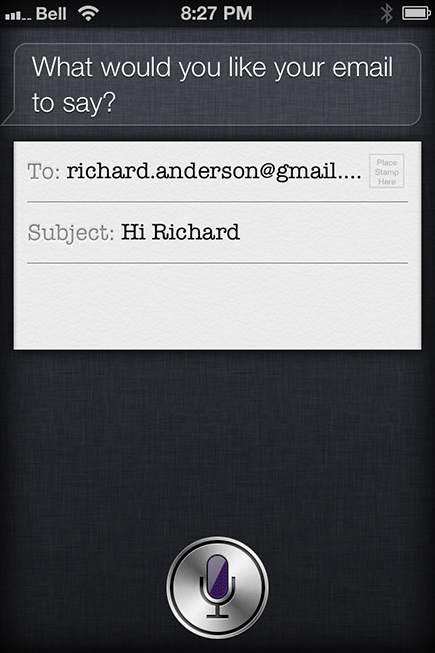
Figure 5-14: Asking Siri to enter an e-mail address.
3. (Optional) If you need to tweak a couple of things, tap anywhere on the screen and make your changes before sending.
4. Say, “Yes,” to send the message.
The iPhone, iPad, and iPod touch confirmation sound confirms the message was sent.
 Siri won’t add this person to your Contacts.
Siri won’t add this person to your Contacts.
Finding e-mails in your inbox
Guess what? Siri isn’t only good for transcribing your voice into e-mail messages. Siri can also help you find e-mails:
![]() Most recent messages: For example, say you have a few hundred messages in your inbox but you want to find the most recent ones? You can simply tell Siri, “Check e-mail” and you’ll immediately see the last 25 e-mail messages that arrived in your inbox.
Most recent messages: For example, say you have a few hundred messages in your inbox but you want to find the most recent ones? You can simply tell Siri, “Check e-mail” and you’ll immediately see the last 25 e-mail messages that arrived in your inbox.
![]() From a specific person: You can ask, “Any new e-mail from Matt today?” and Siri will show you any e-mails received today from anyone named Matt. Or you can say, “Show the e-mail from Lisa yesterday.” Figure 5-15 shows the kinds of things such a request might pull up.
From a specific person: You can ask, “Any new e-mail from Matt today?” and Siri will show you any e-mails received today from anyone named Matt. Or you can say, “Show the e-mail from Lisa yesterday.” Figure 5-15 shows the kinds of things such a request might pull up.
![]() Based on the subject line: You can tell Siri, “Show new e-mail about the doctor’s appointment,” or “Show e-mail about the rent,” and Siri will pull up any relevant messages for you.
Based on the subject line: You can tell Siri, “Show new e-mail about the doctor’s appointment,” or “Show e-mail about the rent,” and Siri will pull up any relevant messages for you.
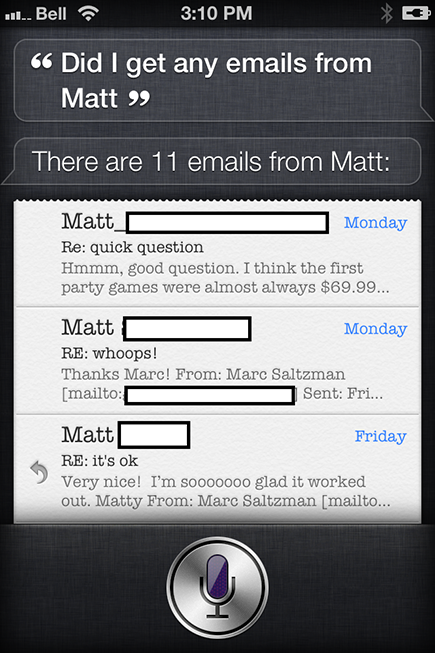
Figure 5-15: The result of asking Siri whether I’ve received an e-mail from “Matt.”
Replying to and forwarding messages
Siri won’t just send an e-mail for you. It’s also possible to reply to or forward an e-mail you’ve already received. For example, while you’re reading an e-mail you can hold down the Home button and tell Siri, “Reply Dear Julie, sorry I had to cancel plans for Saturday’s lunch. I’ll call you later to chat about another date.”
To forward a message, press and hold the Home button while inside of the e-mail and say something like, “Forward e-mail to Phil.” Siri will ask you if you want to add a message as well (“What do you want the e-mail to say?”). See Figure 5-16 for an example of me forwarding a note to my wife, Kellie.
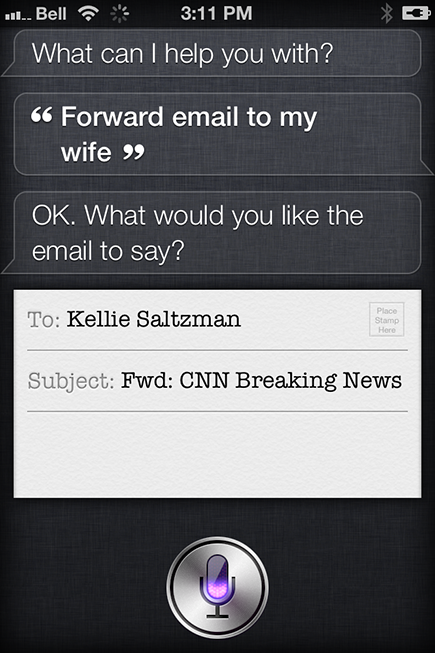
Figure 5-16: In this example, I told Siri to forward this e-mail message to my wife, Kellie.
Composing, Replying to, and Reading Text Messages
Siri is great when it comes to composing, sending, forwarding, and accessing all your e-mails on your iPhone, iPad, or iPod touch, but don’t for a second think that Siri can deal with only e-mail. If you’re of an age to think e-mail is old school and that texting is the wave of the future, that won’t throw Siri for a loop. She can text with the best of them.
Not only can you use Siri to dictate text messages for you, just as you do for e-mail, but Siri can also read your unread text messages aloud, too! (Nope, Siri can’t do this for e-mails but she can for texts.) Now you can continue your jog down the beach without pulling out your smartphone and you can ask Siri to read your texts out loud to you. How convenient, eh?
This portion of the chapter outlines how texting with Siri works, including what you need to say for it to work smoothly, and what you’ll hear back as a response.
Composing a text message
Sending a text message with your voice is incredibly fast and accurate.
There are a couple of different ways to text using Siri. If you’d like to do it one step at a time, the following is the most basic way to compose a text message:
1. Press and hold the Home button.
Wait for the short chime and begin speaking.
2. Say the word “Text” and then the name of the person you want to send a text message to.
Siri opens your iMessage app and puts the name of the person you’re texting in the To field — if he or she is in your Contacts, that is. Flip forward a few pages to see how to text someone who isn’t in your Contacts.
3. In response to Siri’s prompt (“What do you want your message to say?”), dictate your text message.
When you’re done, Siri shows you the message and asks you if you want to send it.
4. Say “Yes” or “Send” to send the message. Or say “No” or “Cancel” to cancel the message.
If it’s sent, you’ll hear the standard whoosh confirmation sound, and the message disappears. (To see it, open up your iMessage app and see the conversation tree with that particular person; your sent texts will be in green.) Figure 5-17 shows what a typical text message would look like, as transcribed by Siri.
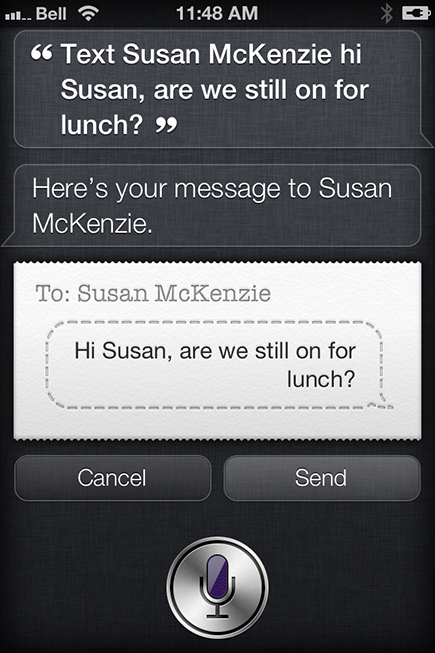
Figure 5-17: Texting is as easy as saying, “Text,” followed by the name of the person you want to send the message to.
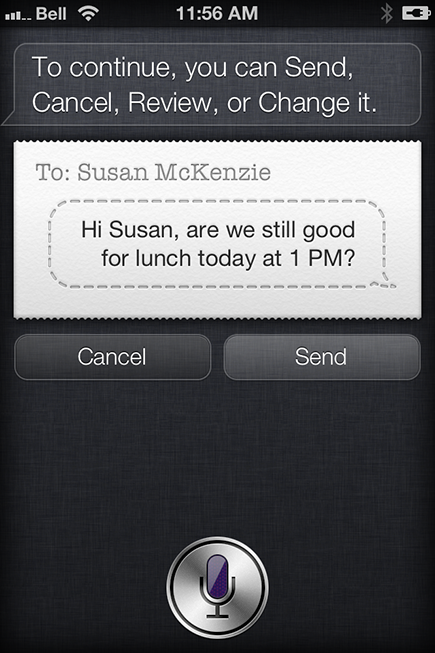
Figure 5-18: You’re given options if you tell Siri not to send the message.
Another way to compose a text message is to say the person’s name you want to text and the message — all in one breath, without waiting for Siri’s prompt. Because texts are usually shorter than e-mails, you might opt to do this to save time. Don’t worry; Siri can handle this without a hitch.
An example of what this might look like follows:
1. Press and hold the Home button.
Begin talking after the chime.
2. Tell Siri, “Text” and the person’s name; after a very short pause, say the message aloud, too.
You’ll hear a high ping, which means Siri is processing your command, and then you’ll see your text message.
3. Review the text message and, if it looks good to you, say “Send” or “Yes.” (If it doesn’t look good, say “No” or “Cancel” to cancel the message.)
Siri will do what you ask, of course. That’s her job as your faithful personal assistant. Figure 5-19 shows an example of a canceled message.
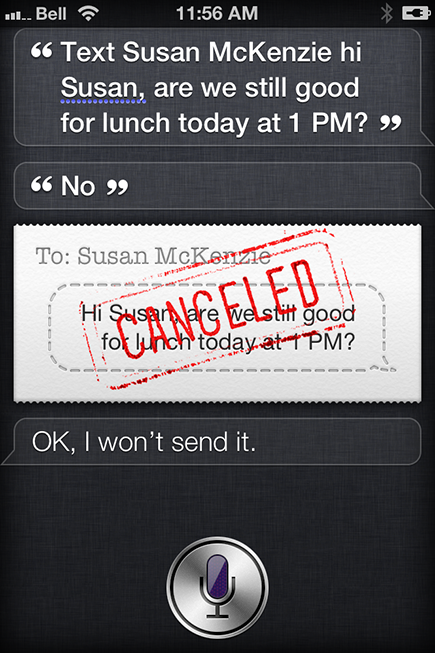
Figure 5-19: Just like a canceled e-mail, Siri stamps the word CANCELED in red.
Texting more than one person
Just as you can send an e-mail to multiple people through Siri, it’s also possible to compose and send an iMessage or traditional text message to more than one recipient. (For sending group e-mails, see earlier in this chapter on how to pull that off via Siri.)
In fact, this can really help save you time. All you need to do is ask Siri to send the text to multiple people, like this:
1. Press and hold the Home button.
When you hear a short chime, you know that Siri is ready for you.
2. Tell Siri “Text” the name of the first person you’d like to text, “and,” and the name of the second person.
 It’s important you say the word “and” between all the names!
It’s important you say the word “and” between all the names!
You can add as many people as you like. You can also wait for Siri to respond with, “What would you like the message to say?” or start saying the message after you tell Siri to whom you’re sending the message (a short pause is best). Figure 5-20 shows what a request for a text message to multiple recipients looks like. You don’t need to say or touch anything to go to the text view shown in Figure 5-21.
3. Review the text message (refer to Figure 5-21) and, if you like what you see, say “Yes” or “Send.” If not, say “No” or “Cancel” and you’ll be prompted with other options, as shown earlier, in Figure 5-18.
If you opt for “Yes” or “Send,” Siri sends the same text message to multiple recipients.

Figure 5-20: Siri transcribes your instructions and shows it to you before opening the iMessage app.
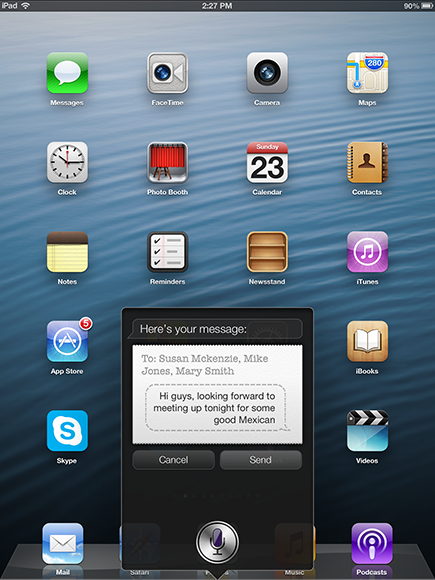
Figure 5-21: The text message to multiple people looks like this.
Composing a text message from within Messages
Just like e-mailing on your iOS device, you can start a text message the old-fashioned way — by opening up Messages and selecting to whom the note will be sent — but then finish it off with your voice, if you like.
Perhaps you decide it would be faster to dictate your text message instead of typing it out. You don’t need to close down the message and start again.
Here’s what you do:
1. In Messages, tap the icon of a little microphone, just to the left of the space bar. (See Figure 5-22.)
2. Speak your text message clearly, then tap the word Done when you’re finished.
Siri shows your words on the screen.
3. If what you see onscreen is accurate — the words are what you said — then tap the green Send button to the right of the speech window.
Siri sends your text message.
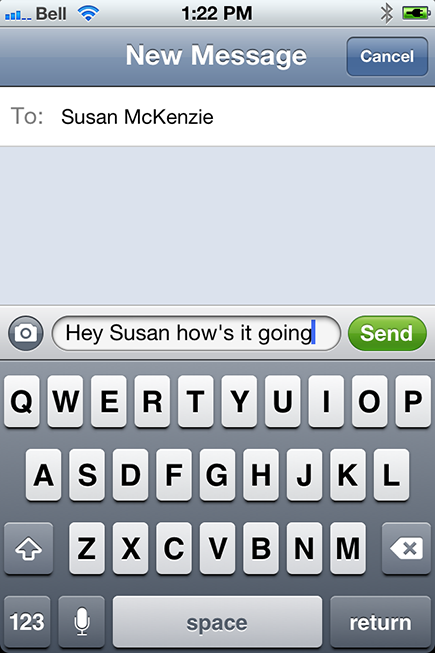
Figure 5-22: See that little microphone icon? Tap it to begin speaking.
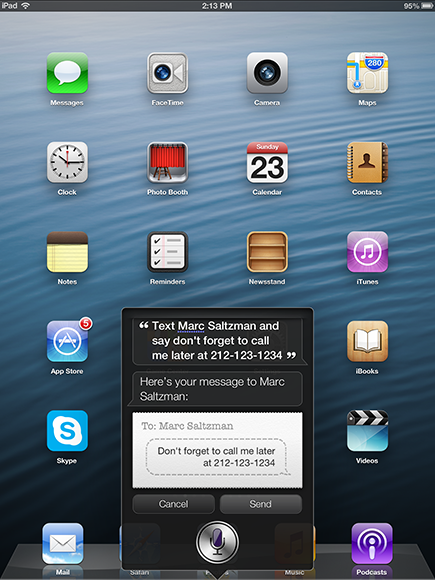
Figure 5-23: You need not say “dash” when giving out your phone number. Siri should know when (and where) to place the dashes in a 10-digit number.
Hearing Your Text Messages Read Aloud
Ah, this is one of the coolest features of Siri: the option to hear your texts read out loud to you.
Say you’ve got a bunch of unread text messages and iMessages on your iPhone, iPad, or iPod touch and you don’t want to tap through each one. After all, you might be concentrating on something you’re looking at — er, like the road in front of your vehicle.
Siri can read your text messages to you in a human-like voice, and you can even respond to them using your voice, too. Now that’s hands-free.
Here’s how to have Siri read your text messages out loud:
1. Press and hold the Home button.
After the short chime, you can give Siri a command.
2. Say something like, “Read me my texts.” See Figure 5-24.
You can make the same request a number of different ways. “Do I have any messages?” works just great.
Siri announces how many messages you have waiting for you. Siri then starts reading all new messages to you, beginning with the sender’s name — or if the name is unknown, the phone number it’s coming from. You won’t see the message on the screen.
3. When prompted by Siri to say what you want to do with the message, say either “Reply” or “Read them again.”
Siri performs the action requested. See Figure 5-25 for an example of my reply to my wife Kellie’s text message.
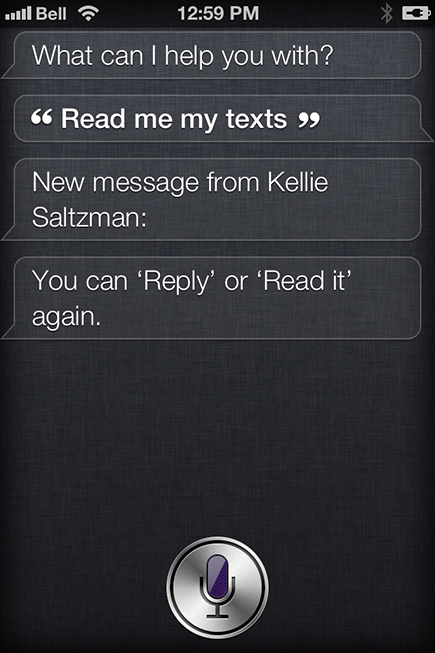
Figure 5-24: Though you don’t see the words here, Siri is reading my new texts to me aloud.
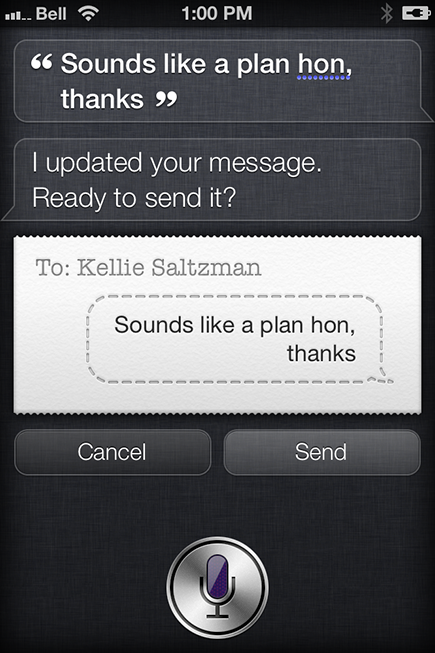
Figure 5-25: Say “Reply” and dictate your reply to the sender. Siri sends the message when you’re done.
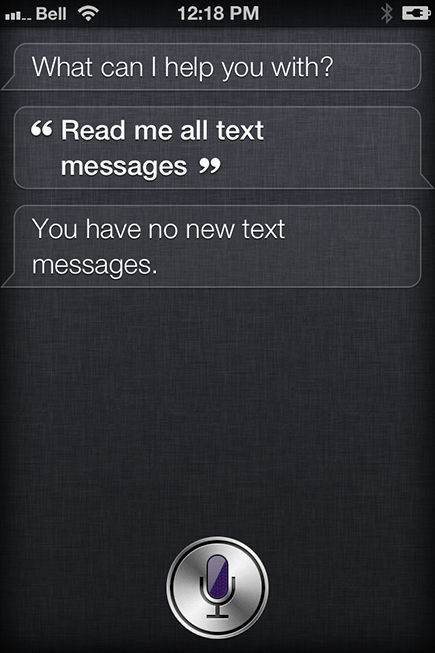
Figure 5-26: Siri tells me there are no new messages because she speaks the text of only unread messages.
![]() “Reply that’s a great idea, thanks.”
“Reply that’s a great idea, thanks.”
![]() “Reply saying that’s a great idea, thanks.”
“Reply saying that’s a great idea, thanks.”
![]() “Tell her I’ll be there in 15 minutes.”
“Tell her I’ll be there in 15 minutes.”
![]() “Call him.”
“Call him.”
![]() “E-mail her.”
“E-mail her.”
![]() “Read it again.”
“Read it again.”
Sending a Text Message to a Phone Number
Okay, so say you’re given a phone number to text, but it isn’t stored in your Contacts. No problem, as Siri can be used to send a text to a 10-digit number, if you prefer.
Maybe you don’t want to add someone to your address book or it’s a one-time text (such as a contest you need to enter via SMS).
All you need to do is say the phone number you want to text, and Siri will know what to do. For instance, do this:
1. Press and hold the Home button.
Siri chimes, letting you know you can start talking.
2. Tell Siri the phone number to text.
As an example, tell Siri, “Text 212-555-1212 [short pause]. Enter me in the drawing, thanks.”
 You can also say, “Message,” or “Tell,” instead of “Text.”
You can also say, “Message,” or “Tell,” instead of “Text.”
Siri shows you the number you want to send the text message to as well as your message.
3. After previewing the number and text message, say “Yes” or “Send,” and Siri will do the rest. If you don’t want to send the text, say “No” or “Cancel.”
See Figure 5-27 for an example of texting a number instead of the name of someone in your Contacts.
Also be aware that you can’t send a picture or video message via Siri. If you said, “Text a photo to my wife,” it won’t ask you which photo to attach; instead Siri will think you want to text the words “a photo” to your wife.
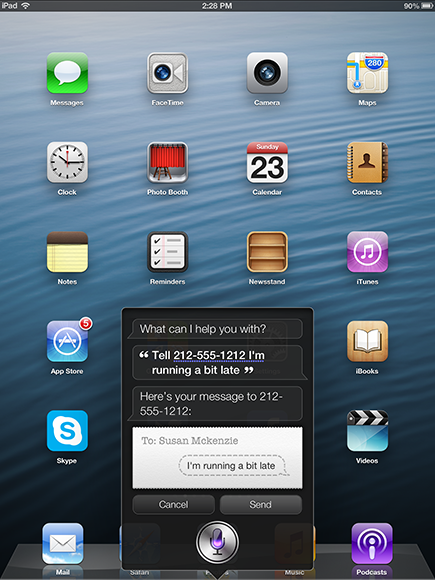
Figure 5-27: Sending a text to a phone number is as easy as saying a name.
Calling a Number or Person (and Starting FaceTime Chats, Too!)
The final part of this chapter covers how you can use Siri to call someone in your Contacts or any phone number you want to call.
Okay, calling a phone number isn’t the most ground-breaking thing Siri can do — cellphones have been able to “voice dial” for many years now — but you’ll find Siri is a lot more accurate at the task. How many times have you said into an old phone “Call home” and your phone replies with “Calling Dr. Lome.” Sigh.
As with all other Siri tasks, all you have to do is ask Siri to perform a task, and she will comply:
1. Press and hold the Home button.
2. Wait for the short chime and then give Siri the command.
For example, you can say “Call” and give the person’s name.
As long as the person is in your Contacts, Siri will call the person for you.
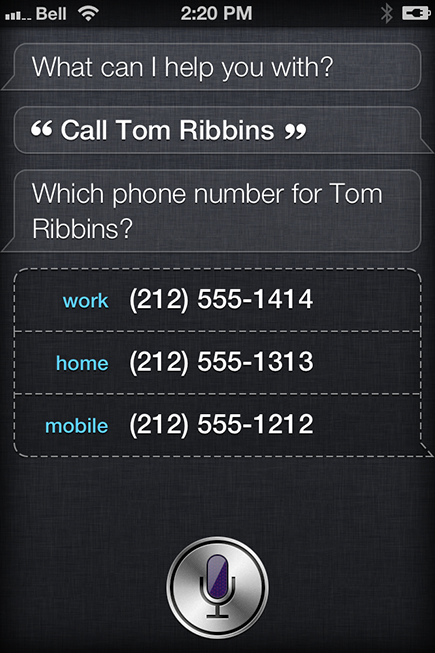
Figure 5-28: Tell Siri the person you want to call. Siri might ask to confirm which number to dial (work, home, and so on).
If you know that a contact listing has multiple phone numbers, you can specify which number to dial, like this:
1. Press and hold the Home button.
2. Begin talking after the short chime.
You could say “Call [person’s name] mobile.” Or “Call [person’s name] home.” Or “Call [person’s name] work.”
You get the idea. Siri knows which number to call because you’re more specific. (See Figures 5-29 and 5-30.)

Figure 5-29: Specify which telephone number Siri should dial.

Figure 5-30: Siri dials the number you requested, such as “home,” “office,” or “mobile.”
If you want to call a phone number that’s not in your Contacts, you can do it by saying the 10-digit number verbally:
1. Press and hold the Home button.
2. Tell Siri what you’d like — but wait for the familiar chime first.
You can say “Call” and give the phone number. Or say “Dial” and give the phone number. (See Figure 5-31.)
Siri dials the number for you right away, of course.
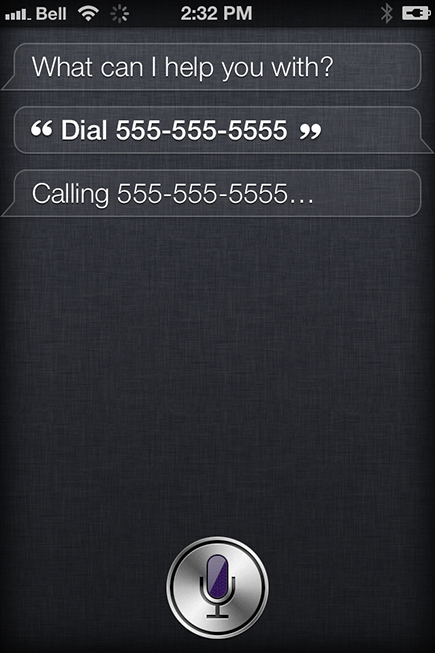
Figure 5-31: Siri can help dial a phone number to someone who isn’t in your Contacts.
Finally, were you aware that Siri can even help make a FaceTime call to someone?
“What’s FaceTime?” you ask. Apple’s FaceTime is a free application bundled into many iOS devices (such as iPhone, iPod touch, and iPad) and Mac computers, allowing you to make video calls to friends, family, and colleagues — meaning they see you and you see them.
Think of FaceTime like its (probably more famous) competitor, Skype. See Figures 5-32 and 5-33.
Imagine, then, that you have a friend in your Contacts and you’d like to FaceTime with them. Without Siri, you’d have to open up your Contacts, get to your friend’s information, and tap the FaceTime button. Boring and time-consuming, right?

Figure 5-32: FaceTime on the iPhone, iPad, or iPod touch is more fun than a phone call because you can see to whom you’re talking.
With Siri, however, you only need to speak the instructions — no matter what you’re doing on the iPhone, iPad, or iPod touch at that time.
Here’s the step-by-step process:
1. Press and hold the Home button.
Wait for the tone.
2. Tell Siri the name of the person you want to FaceTime with, like this: “FaceTime Maya.”
See Figure 5-34 for an example.
Siri begins calling Maya’s FaceTime address on the spot — if Maya is in your Contacts — and you’ll hear the phone ringing, as if you dialed it manually.

Figure 5-33: FaceTime can be done between multiple Apple products, such as these iPod touch devices.
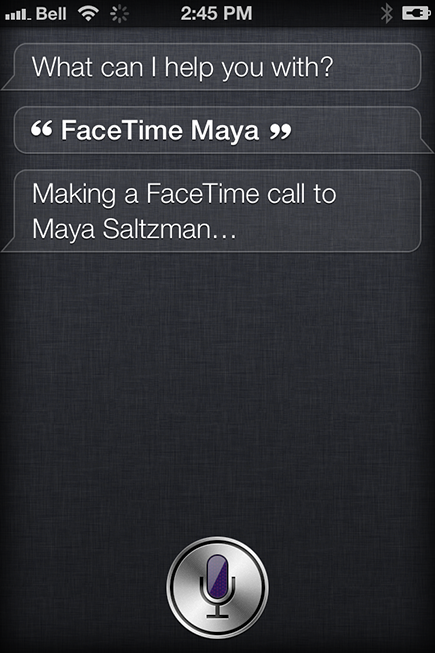
Figure 5-34: Tell Siri the person you’d like to FaceTime with, and the call is made.

 Although using Siri to type e-mails for you is incredibly convenient, resist doing it while you’re behind the wheel of a moving vehicle. You still may need to glance at your phone to catch small errors — or at the very least you might be preoccupied with your e-mail instead of concentrating on driving — so be sure to send your messages after you’ve parked the car. After all, Siri can’t call 9-1-1 for you.
Although using Siri to type e-mails for you is incredibly convenient, resist doing it while you’re behind the wheel of a moving vehicle. You still may need to glance at your phone to catch small errors — or at the very least you might be preoccupied with your e-mail instead of concentrating on driving — so be sure to send your messages after you’ve parked the car. After all, Siri can’t call 9-1-1 for you.